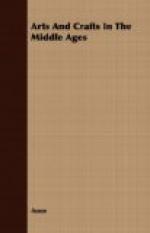On the Sword of Boabdil are many inscriptions, among them, “God is clement and merciful,” and “God is gifted with the best memory.” No two sentiments could be better calculated to keep a conqueror from undue excesses.
Mercia was a headquarters for steel and other metals in the thirteenth century. Seville was even then famous for its steel, also, and in the words of a contemporary writer, “the steel which is made in Seville is most excellent; it would take too much time to enumerate the delicate objects of every kind which are made in this town.” King Don Pedro, in his will, in the fourteenth century, bequeathes to his son, his “Castilian sword, which I had made here in Seville, ornamented with stones and gold.” Swords were baptized; they were named, and seemed to have a veritable personality of their own. The sword of Charlemagne was christened “Joyeuse,” while we all know of Arthur’s Excalibur; Roland’s sword was called Durandel. Saragossa steel was esteemed for helmets, and the sword of James of Arragon in 1230, “a very good sword, and lucky to those who handled it,” was from Monzon. The Cid’s sword was similar, and named Tizona. There is a story of a Jew who went to the grave of the Cid to steal his sword, which, according to custom, was interred with the owner: the corpse is said to have resented the intrusion by unsheathing the weapon, which miracle so amazed the Jew that he turned Christian!
[Illustration: MOORISH SWORD]
German armour was popular. Cologne swords were great favourites in England. King Arthur’s sword was one of these,—
“For all of Coleyne was the blade
And all the hilt of precious stone.”
In the British Museum is a wonderful example of a wooden shield, painted on a gesso ground, the subject being a Knight kneeling before a lady, and the motto: “Vous ou la mort.” These wooden shields were used in Germany until the end of Maximilian’s reign.
The helmet, or Heaume, entirely concealed the face, so that for purposes of identification, heraldic badges and shields were displayed. Later, crests were also used on the helmets, for the same purpose.




